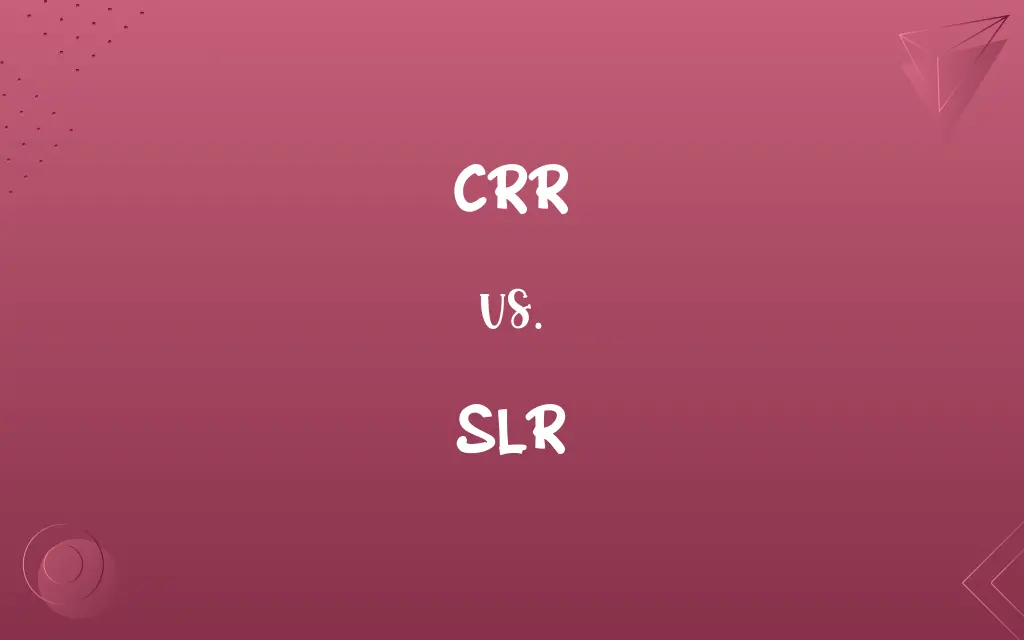CRR vs. SLR: Know the Difference

By Shumaila Saeed || Published on January 26, 2024
CRR (Cash Reserve Ratio) mandates a portion of a bank's deposits to be held in cash at the central bank, while SLR (Statutory Liquidity Ratio) requires banks to maintain a percentage of deposits in liquid assets e.g., cash, gold, or government securities.

Key Differences
CRR (Cash Reserve Ratio) refers to the mandatory proportion of deposits that commercial banks must hold as reserves either in cash or as deposits with the central bank. It is primarily used by central banks to regulate liquidity and control the money supply. SLR (Statutory Liquidity Ratio), on the other hand, is the minimum percentage of deposits that a bank has to maintain in the form of gold, cash, or approved securities. The main purpose of SLR is to ensure the solvency of banks and to control the expansion of bank credits.
Shumaila Saeed
Jan 26, 2024
CRR impacts the lending capacity of banks. A higher CRR means banks have less money to lend, which can help control inflation but may slow down economic growth. This ratio does not earn any interest for the banks. SLR impacts both the credit growth and the liquidity position of banks. By changing the SLR, the central bank can influence the bank's credit expansion ability. Unlike CRR, banks earn returns on assets held for SLR requirements.
Shumaila Saeed
Jan 26, 2024
CRR is a crucial monetary policy tool used by central banks to control the money supply and banking sector liquidity. It directly affects the deposit amount banks can use for lending and investment purposes. SLR, in addition to being a monetary control measure, serves as a safety net for both the depositors and the banks. It ensures that banks have a sufficient reserve of liquid assets to meet potential demands from depositors.
Shumaila Saeed
Jan 26, 2024
CRR does not provide any return to the banks. It is essentially a portion of the deposits that banks cannot use for any income-generating activities. In contrast, SLR assets can be income-generating, as banks are allowed to earn interest on the securities they hold to meet the SLR requirement.
Shumaila Saeed
Jan 26, 2024
CRR is a more direct tool for controlling the money supply, making it a critical aspect of monetary policy. It helps in maintaining the trust of depositors in the banking system. SLR is more focused on the liquidity of banks. It helps in regulating the credit growth in the economy and ensures banks have enough liquid assets during financial emergencies.
Shumaila Saeed
Jan 26, 2024
ADVERTISEMENT
Comparison Chart
Definition
Percentage of total deposits banks are required to hold in cash with the central bank.
Percentage of total deposits banks must maintain as liquid assets like cash, gold, or government securities.
Shumaila Saeed
Jan 26, 2024
Purpose
Controls liquidity in banking system, regulates money supply.
Ensures solvency of banks, regulates credit expansion.
Shumaila Saeed
Jan 26, 2024
Impact on Bank Lending
Reduces funds available for lending, directly impacting loan disbursement.
Limits credit expansion, ensures liquidity for meeting depositors' demands.
Shumaila Saeed
Jan 26, 2024
Returns for Banks
No interest earned on the reserve.
Banks earn returns on SLR assets.
Shumaila Saeed
Jan 26, 2024
Role in Monetary Policy
Direct tool for monetary control, affects money supply and deposit volume available for bank activities.
More focused on liquidity management, ensuring banks' capability to meet demands in financial emergencies.
Shumaila Saeed
Jan 26, 2024
ADVERTISEMENT
CRR and SLR Definitions
CRR
CRR is a critical component of central banking policy for maintaining economic balance.
The central bank uses CRR adjustments as a response to fluctuating economic conditions.
Shumaila Saeed
Jan 08, 2024
SLR
SLR is a regulatory tool used to ensure the liquidity and stability of the banking system.
SLR helps safeguard the financial system during times of economic uncertainty.
Shumaila Saeed
Jan 08, 2024
CRR
CRR is a regulatory requirement for banks to hold a certain proportion of their deposits in reserve.
Banks are required to report their CRR to the central bank regularly.
Shumaila Saeed
Jan 08, 2024
SLR
SLR is a buffer of highly liquid assets that banks maintain to meet depositors' demands and other obligations.
SLR acts as a safety net for banks during financial downturns.
Shumaila Saeed
Jan 08, 2024
CRR
CRR is the mandatory percentage of total deposits banks must keep as reserves with the central bank.
When the central bank increased the CRR, banks had less money available for lending.
Shumaila Saeed
Jan 08, 2024
ADVERTISEMENT
SLR
SLR is a component of the prudential norms that banks must adhere to for sound financial management.
Banks must regularly report their compliance with SLR requirements to regulatory authorities.
Shumaila Saeed
Jan 08, 2024
CRR
CRR is a monetary policy tool used to regulate bank liquidity and control money supply.
The central bank adjusted the CRR to manage inflation and promote economic stability.
Shumaila Saeed
Jan 08, 2024
SLR
SLR (Statutory Liquidity Ratio) is a requirement for banks to maintain a specific percentage of their deposits in liquid assets like government securities.
The bank had to purchase government bonds to meet its SLR obligation.
Shumaila Saeed
Jan 08, 2024
CRR
CRR represents the cash reserve banks are required to maintain to ensure depositor security and trust.
The bank's CRR compliance ensures customer deposits are securely backed.
Shumaila Saeed
Jan 08, 2024
SLR
SLR is a reserve ratio set by central banks to control the money supply and credit flow in the economy.
The central bank increased the SLR to curb inflationary pressures.
Shumaila Saeed
Jan 08, 2024
Repeatedly Asked Queries
What is the current CRR rate in India?
The CRR rate in India varies and is determined by the Reserve Bank of India (RBI). It can change over time.
Shumaila Saeed
Jan 26, 2024
How is CRR calculated?
CRR is calculated as a percentage of a bank's total demand and time deposits.
Shumaila Saeed
Jan 26, 2024
What happens if a bank does not maintain the required CRR?
Banks failing to maintain the required CRR may face penalties and restrictions on lending.
Shumaila Saeed
Jan 26, 2024
Why is CRR imposed by the central bank?
CRR is imposed to control the liquidity in the banking system and to ensure the stability of the financial system.
Shumaila Saeed
Jan 26, 2024
Why is SLR imposed by the central bank?
SLR ensures that banks have a certain level of liquidity to meet their depositors' demands and maintain stability in the financial system.
Shumaila Saeed
Jan 26, 2024
How is SLR calculated?
SLR is calculated as a percentage of a bank's net demand and time liabilities (NDTL).
Shumaila Saeed
Jan 26, 2024
What types of assets can be included in SLR investments?
Assets like government securities, gold, and approved securities can be included in SLR investments.
Shumaila Saeed
Jan 26, 2024
What is CRR?
CRR stands for Cash Reserve Ratio, which is the portion of a bank's deposits required to be held in cash with the central bank.
Shumaila Saeed
Jan 26, 2024
What is SLR?
SLR stands for Statutory Liquidity Ratio, which mandates the percentage of a bank's total deposits to be invested in safe and liquid assets.
Shumaila Saeed
Jan 26, 2024
Do CRR and SLR rates change frequently?
Yes, both CRR and SLR rates can change periodically based on the central bank's monetary policy.
Shumaila Saeed
Jan 26, 2024
Are CRR and SLR applicable in all countries?
No, CRR and SLR policies may vary by country, and not all countries implement these requirements.
Shumaila Saeed
Jan 26, 2024
What is the current SLR rate in India?
The SLR rate in India is determined by the Reserve Bank of India (RBI) and can change over time.
Shumaila Saeed
Jan 26, 2024
What is the main difference between CRR and SLR?
The key difference is that CRR requires banks to hold a portion of their deposits in cash with the central bank, while SLR mandates banks to invest in specific liquid assets.
Shumaila Saeed
Jan 26, 2024
Which one has a more direct impact on a bank's lending capacity, CRR, or SLR?
CRR has a more direct impact on a bank's lending capacity, as it restricts the amount of money available for lending.
Shumaila Saeed
Jan 26, 2024
Can banks use the same assets to fulfill both CRR and SLR requirements?
No, banks cannot use the same assets to fulfill both CRR and SLR requirements; they must maintain separate assets for each.
Shumaila Saeed
Jan 26, 2024
Share this page
Link for your blog / website
HTML
Link to share via messenger
About Author
Written by
Shumaila SaeedShumaila Saeed, an expert content creator with 6 years of experience, specializes in distilling complex topics into easily digestible comparisons, shining a light on the nuances that both inform and educate readers with clarity and accuracy.









































































